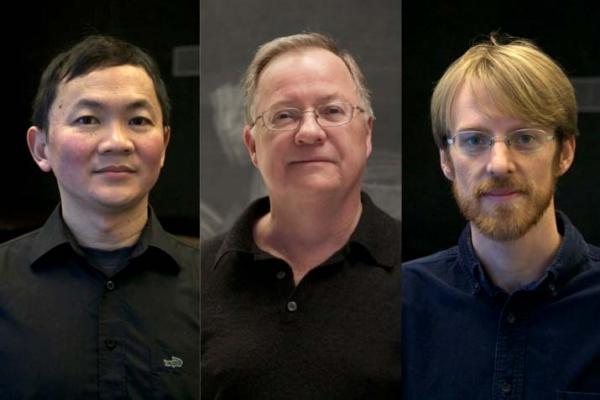
Astrophysicists join forces to measure dark energy
Published: January 24, 2013
It's an unprecedented experiment aimed at understanding what is causing the acceleration of the expansion of the universe.
And it is bringing together University of Toronto astrophysicists from the Canadian Institute for Theoretical Astrophysics (CITA), the Canadian Institute for Advanced Research (CIFAR) and the Dunlap Institute, with collaborators at the universities of British Columbia and McGill, and the Dominion Radio Astronomy Observatory.
“The motivation is to make a precise measurement of dark energy and the real hope is that the dark energy is changing with time,” said U of T Professor Ue-Li Pen, associate director of CITA.
The Canadian Foundation for Innovation will invest $4.6 million to build an innovative new digital radio telescope and make a three-dimensional map of the largest volume of the observable universe to date through a technique being pioneered in Canada called hydrogen intensity mapping. Matching funds from collaborating institutions including the provincial governments will bring the total funding for the experiment, known as CHIME, to $11 million.
“CHIME would be a way to see if dark energy is a constant," said Pen.
U of T Professor Dick Bond, director of CIFAR's cosmology and gravity program, explained: “the origin of accelerated expansion is inextricably tied to how gravity interacts with the ‘vacuum energy’ whose nature has been the greatest mystery in physics for eighty years. This mystery connects the late universe acceleration which CHIME probes to early universe acceleration which we at CITA are also probing via cosmic background radiation experiments such as Planck, ACTpol, ABS and Spider. For CITA theorists the exciting data that will emerge is a rich treasure trove.”
Planck is a satellite-born telescope measuring fluctuations in the cosmic background at unprecedented sensitivity and small scales over the whole sky. ACTpol is the polarization-sensitive Atacama Cosmology Telescope. ABS stands for Atacama B-mode Search which is looking for signatures of inflation in the CMB, and Spider is a balloon-borne experiment that will be launched from Antarctica next winter to searching for the cosmic gravitational wave background. It is being built by a team including CIFAR and U of T’s Barth Netterfield.
“CHIME is poised to be a great coup for Canadian astronomy,” said U of T Professor Norm Murray, director of CITA. “The experiment will tell us about the expansion history of the Universe well after the inflationary period leading to the Big Bang and the emission of the microwave background, but well before the current accelerated expansion revealed by the observations of supernovae that were awarded the Nobel prize in 2011."
"CITA's involvement in CHIME will allow us to continue our world-leading position in observational cosmology, following on CITA's involvement in WMAP and Planck," Murray said. "It is also illustrative of CITA's leadership in Canada-wide projects in both theoretical and observational astronomy.”
CHIME will chart the expansion beginning in the period when cosmic acceleration appears to have turned on, from something like 11 billion years ago (redshift 2.5) until aproximately 6.5 billion years ago (redshift 0.8).
The ambition is large.
“We've been mapping the universe for a hundred years since Edwin Hubble and to date we've mapped maybe one per cent of that, and CHIME wants to map about a quarter of the observable universe,” Pen said.
CHIME will use a new technique called hydrogen intensity mapping pioneered by a team led by Pen, which allows a radio telescope to map the structure of the universe in neutral hydrogen gas directly using radio observations, rather than using optical telescopes to methodically catalogue each galaxy. It allows astrophysicists to survey huge volumes of the universe in three dimensions, and for a fraction of the cost of other methods.
The hydrogen intensity mapping will have many applications, said Assistant Professor Keith Vanderlinde from U of T's Dunlap Institute, but the main goal is to amass the amount of data needed of the evolution of the universe over time to probe what is accelerating its expansion. It promises to “reveal cosmic acceleration in unprecedented detail.”
The experiment will use a new hybrid of both digital and analog radio telescope technology. A traditional telescope’s parabolic dish must be pointed. A digital software telescope has no curvature, no preferred direction, and is simultaneously pointed in all directions of the sky at the same time, Pen explained, "which is pretty sweet, obviously."
CHIME will be built at the Dominion Radio Astronomy Observatory sheltered in the Okanagan Valley near Penticton, British Columbia on a radio-quiet reserve protected from local radio-frequency interference by federal regulation and the surrounding hills. It will be a set of five 100-metre long x 20 metre half-pipes, lying side by side in a 100 metre-square array constructed of common building materials, metal roofing struts, concrete legs and wire mesh, and will have no moving parts. It will work digitally in the North-South direction along the length of the half pipes, and will work as an analog telescope in the East-West direction. It will scan the sky above it in a line from horizon to horizon as the earth turns every day, and stack the data it collects.
"The great collaboration of CITA with the Canadian Institute for Advanced Research, Cosmology and Gravity Program and its cross-Canada nodes extends to our CHIME initiative,” said Bond.
The CIFAR Cosmology and Gravity Program members engaged are: two CIFAR Fellows at CITA (Pen and Bond), one Fellow at McGill (Matt Dobbs), two Fellows at UBC (Gary Hinshaw and Mark Halpern) and Vanderlinde – a member of the CIFAR Junior Fellow Academy at U of T's Dunlap Institute and the Department of Astronomy and Astrophysics. As well, CITA post doctoral Fellows and graduate students are involved in CHIME research.
The CFI funded CHIME through its Leading Edge Fund which invests in state-of-the-art infrastructure for Canada’s research institutions to attract and retain world-class talent and train a new generation of researchers.



